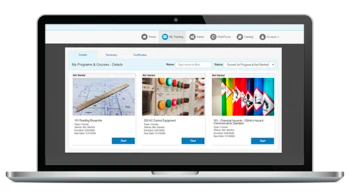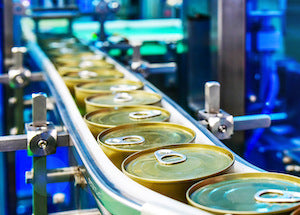The "Nonmetals in the Plant" course introduces major nonmetal materials and how they are most frequently used. Describes properties, characteristics, and classifications of each material. Covers synthetic and natural materials. Examines various paints and coatings, their proper use, preparation, and application. Surveys industrial chemicals. Chemical safety precautions are covered, along with the proper use of protective equipment. This course has no prerequisites. Nonmetals in the Plant is available in online maintenance training and course manual formats.
TPC Training is authorized by IACET to offer 0.5 CEUs for the online version of this program.
Lesson 1 - Introduction to Nonmetals
Topics:
Properties and behavior of solids, liquids, and gases; Boyle's Law; Laminar and turbulent flow; Mixed-phase systems
Learning Objectives:
– State the definition of a solid, a liquid, and a gas.
– Demonstrate how to change a liquid to a solid.
– Demonstrate buoyancy.
– Identify an object less dense than water, and an object more dense than water.
– List six possible combinations of matter.
Lesson 2 - Plastics
Topics:
Characteristics; Processing; Molding; Casting; Extruding; Reinforcing; Machining; Welding; Patching
Learning Objectives:
– State the definition of a thermoplastic and a thermoset.
– Describe injection molding, foam molding, and extrusion.
– Select the best bonding agent for joining polyethylene parts.
– Describe the steps in patching a damaged area with glass-plastic material.
Lesson 3 - Rubber
Topics:
Properties; Processing; Kinds and uses; Vulcanizing; Foam rubber; Hose and tubing; Tank linings; Reclaiming rubber
Learning Objectives:
– Name four properties of rubber.
– Explain the vulcanizing process.
– Select the best hose for handling oils or gasoline.
– Describe how to use a pinhole locator.
– List the kinds of sheet rubber that should be kept on hand in the storeroom of an industrial maintenance department.
Lesson 4 - Wood
Topics:
Properties; Grades and defects; Measuring lumber; Plywood; Choosing wood; Joints; Preservation; Industrial uses; Fasteners
Learning Objectives:
– State the definition of hardwood and softwood.
– Name the grades of softwoods and hardwoods.
– Describe a radial cut, a crosscut, and a tangential cut.
– Demonstrate how to calculate the number of board feet in a piece of 2 x 8 lumber 10 ft long.
Lesson 5 - Construction Materials
Topics:
Concrete; Masonry units; Brick; Mortar; Patching and repairing; Wallboard; Plaster; Glass
Learning Objectives:
– List the ingredients in concrete.
– State the definition of spalling, crazing, and dusting.
– Explain how to remove an oil stain from concrete.
– Demonstrate how to mix a small batch of mortar.
– List the steps in repairing a hole in wallboard.
Lesson 6 - Insulating Materials
Topics:
Heat flow; Thermal, loose-fill, blanket, low-density, and acoustic insulation; Vapor barriers; Electrical insulation; Fire prevention
Learning Objectives:
– Name the ways by which heat can be transferred.
– State the formula for determining the thermal conductivity coefficient (k value) of a thermal insulator.
– Demonstrate how to install blanket insulation.
– Select the best materials for use an electrical insulation where resistance to flame and high temperature is important.
– List the safety rules that should be followed when working with insulating materials.
Lesson 7 - Paints and Coatings
Topics:
Protective materials; Substrates; Paint; Primer; Choosing a coating; Surface preparation; Application; Using colors; Special coatings
Learning Objectives:
– List the factors to consider in selecting a protective coating.
– Name the qualities and characteristics of pigments and vehicles.
– List the safety precautions to follow when using paints containing solvent thinners.
– State the definition of primer.
– Demonstrate how to prepare a metal substrate for coating.
Lesson 8 - Industrial Chemicals
Topics:
Safety; Soaps and detergents; Solvents; Acids; Aerosols; Oils; Refrigerants; Water-treatment chemicals; Fuels; Fire-fighting chemicals
Learning Objectives:
– List the safety precautions to follow when working with liquid and solid chemicals.
– Name the general classifications of cleaning agents.
– Select the best acid for cleaning stainless steel and aluminum.
– State the reasons why aerosol spray cans are potentially dangerous.
– List considerations in selecting an oil for a particular use.
Lesson 9 - Adhesives
Topics:
Kinds of adhesives; Glues; Plastic welding; Acrylic-based adhesives; Other adhesives; Strength of adhesives; Tapes
Learning Objectives:
– State the definitions of adhesiveness, curing, drying, joint, pot, life, and tack.
– List the characteristics of thermosetting and themoplastic adhesives.
– Demonstrate the plastic-welding process.
– Select the best tapes for insulating and protecting electrical connections and wires.
Lesson 10 - Carbon
Topics:
Forms and properties; Electrodes and resistors; Carbon brushes; Industrial diamonds; Carbon seals; Graphite packing; Chemical resistivity
Learning Objectives:
– List four uses of carbon and fabricated carbon products in industry.
– List three properties of carbon that make it useful in electrical and mechanical applications.
– Describe the carbon-arc welding process.
– List the most common causes of brush noise.
– Demonstrate the correct method of cutting individual rings from a continuous length of braided packing.
↺ Back to Industrial Fundamentals Online Training Courses Courses





